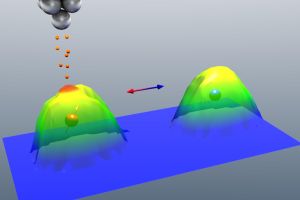Researchers at the The Karlsruhe Institute of Technology (KIT) have embedded an iron atom into a nanometer-sized molecule consisting of 51 atoms to enable it to function as an on-off binary switch. The molecule acts as protection for the charge allowing the molecules to be packed together closely without worrying about the superparamagnetic effect which limits smaller bit sizes in hard disks. According to Engadget, magnetic storage such as a spinning disk needs a whopping 3 million atoms per bit meaning this new discovery can theoretically store 3 million times as much data in the same amount of space.
embedded an iron atom into a nanometer-sized molecule consisting of 51 atoms to enable it to function as an on-off binary switch. The molecule acts as protection for the charge allowing the molecules to be packed together closely without worrying about the superparamagnetic effect which limits smaller bit sizes in hard disks. According to Engadget, magnetic storage such as a spinning disk needs a whopping 3 million atoms per bit meaning this new discovery can theoretically store 3 million times as much data in the same amount of space.
The downside? At this moment you need a scanning, tunneling microscope to write the data – or change it from positive to negative. A quick Google search resulted in an ad for one of these devices which touted a complete system price of $49,000. Reading the data however is easier as you just measure its resistance according to KIT researchers.
microscope to write the data – or change it from positive to negative. A quick Google search resulted in an ad for one of these devices which touted a complete system price of $49,000. Reading the data however is easier as you just measure its resistance according to KIT researchers.
If the reading and writing mechanism can be shrunk sufficiently we may see the results of this research in our smartphones some day in the future. And it kind of makes you wonder how much more useful your mobile devices would be if they could store many thousand times more storage in the same amount of space.





